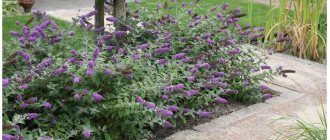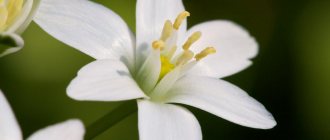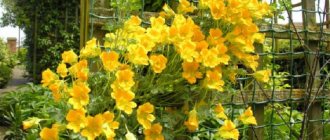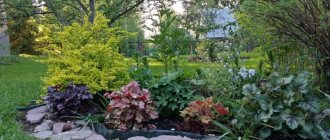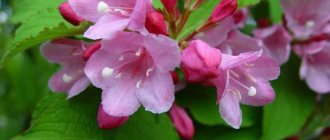The beginning of autumn does not necessarily mean goodbye to garden flowers - it is a time when you can admire some autumn plant species on your yard! Colchicum's beautiful purple flowers appear in September and herald the coming fall. Gardens, terraces and balconies can be decorated with pastel colors of their delicate petals. They begin flowering in late summer and end in October. We will tell you how to grow colchicum - planting and care in open ground, and present photos of interesting varieties.
Life cycle
Spring-blooming species, such as Colchicum Hungarian, produce leaves and flowers at the same time. But colchicums or autumn flowers got their name because of plants that prefer to bloom at inopportune times - in the fall, often in September.
These flowers have two periods of active development and two periods of rest. In nature, colchicum grows in countries with dry summers and uses two moisture-rich periods of the year for its growth - spring and autumn.
In early spring, the colchicum plant produces a rosette of large, fleshy, elongated leaves, the height of which depends on the type of colchicum.
The leaves, somewhat similar to the leaves of the lily of the valley, feed the corm hidden in the ground. The more the corm grows, the more greenery it produces. Leaves die off by mid-June - early July.
Use in landscape design
Colchicum, when it blooms in the fall, always looks very impressive in a flowerbed; it is impossible not to pay attention to it. Delicate and fragrant flowers appear at the moment when your garden has already faded and is preparing to rest
Blooming bright islands of colchicum will be an appropriate decoration for the local area; they can enliven the space near the fence, place along the edge of the border of various flower beds, plant in a rocky rock garden or decorate an alpine hill.
Landscape designers recommend planting juniper or dwarf fir next to the colchicum. This combination looks incredibly beautiful when pale pink inflorescences appear against the background of a dark green mass. Some gardeners are trying to place plants next to the colchicum that could cover with their foliage the bare peduncles of this bulbous perennial. But because of his love for dry soils, finding a harmonious neighborhood can be quite difficult.
Autumn colchicums are presented in the video below.
Colchicum flowerbed in summer
The unattractive appearance of the above-ground part of the colchicum makes you want to prune it. When the leaves dry completely, this can be done.
But this solution has disadvantages:
- leaves are an excellent fertilizer intended for the flower by nature itself;
- You can accidentally trim the leaves ahead of time and deprive the bulb of nutrition. Colchicums are unpretentious, but it is better not to cut rare purchased double varieties and let the delicate, expensive flower go through the development cycle completely on its own.
Unsightly summer remnants of colchicum in a flowerbed are a problem that can be solved by planting colchicum together:
- with decorative cereals,
- woody plants, for example, gray spirea, weeping caragana tree, creeping forms of juniper.
It is important to combine the planting of a flower with other species in order to prevent weeds from overgrowing the empty land during the dormant autumn period. Colchicum is replanted due to the growth of the corm every 4 years, so it goes well with ground cover perennials.
When the perennials grow, there will be no need to remove weeds, which will be an additional advantage to the aesthetic appeal of the flower bed.
History of appearance
The first mentions of Colchicum, or Colchicum, are found in ancient writings of civilizations such as Egypt, India and Greece. Wild crocus grow throughout Europe, Asia and the Mediterranean. The juice of these plants was used to treat gout and rheumatism. In the nineteenth century, doctors began to study colchicum. After fifty years of research, mass production of colchicum preparations began. Colchicum is listed in the Red Book and given the status “rare”.
Habitat
The distribution area of colchicum covers the entire territory of Europe, excluding the Scandinavian countries and the Baltic region. Most often, plants are found in the Carpathians, Polesie and Podolia.
Autumn colchicum prefers lowlands, floodplain meadows, and mountain slopes, where it forms huge foci of several hectares. It can grow in pastures and gardens, preferring fertile loams and sandy loam soils.
Important! Colchicum seeds are small, so they are spread by the wind and with the help of ants.
Flowering period
Flowers, more than a dozen per corm, which very quickly and actively grow with children, appear in September. Late bulbs can grow in November.
When early frosts occur, a spring picture is observed in the flowerbed, when bright flowers break through the white snow. Photos of colchicum at such a moment can be confused with photos of snowdrops. Flowers are not afraid of a sharp drop in air temperature, straightening up with warming.
The flower is pushed out of the ground by fused perianth tubes; leaves do not appear during the second period of activity. For this defenseless white or light green naked neck, uncovered by leaves, Colchicum is called the “naked lady.”
Autumn flowers are white, yellow, pink, lilac and purple. Terry species have several dozen petals. The flowers fade within three weeks. The resulting ovary will develop and come to the surface in the spring along with a rosette of leaves in the form of a seed capsule.
Description
The colchicum flower is one of the perennial bulbous ephemeral plants. This means that the growing season of the autumn plant is short in time. The dark green leaves have an elongated lanceolate shape. The period of their development occurs in the spring, and in the summer the vegetation dies off and goes into a dormant state.
The most interesting thing begins with the onset of the first frost: funnel-shaped buds up to 3 cm in diameter emerge from the soil. At the same time, the height of the above-ground part is only 10-30 cm, and most of the perianth is hidden underground.
Although there are varieties that bloom in the spring along with primroses, it is the late varieties that have gained popular recognition. An oblong corm 3-5 cm long, covered with brown scales.
After flowering, colchicum manages to form a seed pod located in the ground. She will be born only with the first spring leaves.
Colchicum is one of the most poisonous inhabitants of the garden. Dangerous substances that cause skin irritation and burns are contained in all its parts. Even the water in which the flowers stood can cause harm.
Basic safety rules state that you should not touch a flower without gloves, and garden tools and equipment should be washed after finishing work.
Breeding and transplanting
Colchicums grow well in one place for 4 years. As the corms become stronger, they bloom more abundantly. Then, the colchicum needs to be transplanted.
Propagation with bulbs
The flower is dug up after the leaves have completely withered in July. Daughter bulbs are selected. You can divide a healthy large corm into growing points and plant each part separately after preparation, but this is usually not necessary.
If the transplanted autumn tree species is capable of producing children, then there are always many of them. Colchicum corms are washed, separated, treated with potassium permanganate, dried and stored like bulbs of other plants, maintaining a temperature of 22-24 °C.
When planning to buy colchicum bulbs, pay attention to the presence of a tube from the elongated ends of leaf scales. When planting, it is directed upward; it will protect the sprout when passing through the ground. This tube is not cut. It is important to treat colchicum against fungal infections. Gray rot is the only disease of colchicum.
August is the ideal time to plant autumn trees in the ground. The plant is at this moment in deep dormancy. Autumn corms are unpretentious; they can be planted without a summer drying period.
Bulbs dug up right before flowering will take root, but will bloom later. Colchicum can be planted even if there are flowers. Such flowers will immediately wither due to stress, but the plant itself will take root.
Colchicum bulbs are buried in loose soil to 3 heights; when planted in dense soil, they are buried to 2 heights. The distance between large bulbs is 20 cm, so that there is enough space to grow for 4 years. If small bulbs are planted every 10cm, this planting also protects the flowers from lodging.
Propagation by seeds
The plant was called in Latin “son before father”, since the seed capsule appears along with the leaves and ripens by the end of May. It turns out that first the gardener sees the son (the seeds are the children of the flowers), and then the father sees the flowers.
When germinating, the seed pods resemble a narrow bud. As they ripen, they darken. It is inconvenient to propagate colchicums by seeds. A plant sprouted from a seed begins to bloom in the 4th year at best, and in most cases 6-7 years from the moment of planting.
At the same time, the colchicum corm grows easily and the problem of collecting children for reproduction occurs only in some types of flowers that do not form child bulbs. Such, for example, is the yellow colchicum. But this happens, and mainly concerns species that bloom in spring.
Popular types
The most popular species grown in our gardens:
- Colchicum splendid - Colchicum speciosum;
- B. byzantine – Colchicum byzantinum;
- B. autumnale – Colchicum autumnale;
- B. hybrid – Colchicum hybridum;
- B. mountain – Colchicum montanum.
Autumn
One of the most popular species of the genus is Colchicum autumnale, which pleases with large flowers up to 10 cm in diameter. Found in the wild in Africa and Europe. Flowering plants can also be found in foothill areas. One tuber can produce several flowers up to 15 cm high and about 10 cm in diameter.
According to the World Conservation Union, it is an endangered species.
Interesting varieties:
- "Albiflorum" Albiflorum with white flowers;
- "Purpureum" Purpureum with purple flowers;
- "Antares" Antares with delicate white-purple flowers;
- “Water Lily” Waterlily – its lush flowers resemble water lilies.
Photo. Autumn colchicum
Hybrid
Garden hybrids bred by crossing several species are very popular. As a result of breeding work, numerous varieties of beautifully flowering plants have been obtained, very diverse, with large flowers and many shades of purple and pink. Unfortunately, these are short-lived specimens. They do not grow, but in return they give lush blooms.
Byzantine
The least demanding, abundantly flowering species is the Byzantine colchicum (Colchicum byzantinum). It produces up to a dozen flowers from one tuber and reaches a height of 20 cm. Its natural habitat is in Asia Minor.
Photo. Colchicum Byzantine
Fabulous
The species Colchicum speciosum lives in the Caucasus. The flowers are very large, up to 15 cm in diameter, with a plant height of 25 cm. It may not bloom as profusely as the Byzantine species, but the number of flowers is higher than that of the autumn species, reaching 10 flowers per bulb.
Photo. Colchicum splendid
Among the varieties is the one with white flowers.
Motley
Colchicum variegatum produces wide, funnel-shaped, red-purple flowers with a prominent checkered pattern.
Interesting varieties grown in gardens
There are many noble varieties of colchicum. Commercially available varieties differ mainly in color, size, number and structure of flowers. You can choose from varieties with white, pink or purple flowers (and all their shades), as well as double or single petals. Terry varieties are the most beautiful, but they are more sensitive to cultivation and less frost-resistant.
| Variety name, description | Photo |
| Colchicum autumnalis "Waterlily" Waterlily - with purple-pink double flowers, shaped like water lilies. Height – 15 cm. | |
| "Antares" Antares - the variety pleases with the unique delicacy of white and pink flowers. | |
| “Innocence” Innocence is a variety of Byzantine colchicum. | |
| "Giganteum" Giganteum is a variety with exceptionally large flowers. | |
| “Album” Album is a variety with white flowers. Plant height – 8-30 cm. | |
| “Alboplenum” Alboplenum – height: 15 cm. Flowers: white. The leaves are long and hanging. | |
| "Albiflorum" Albiflorum - white flowers. | |
| "Atrorubens" Atrorubens with flowers in shades of pink. | |
| “Giant” Height: 20-30 cm Flowers: lilac. Flowering time: August – September. | |
| "Dombai" Dombai - large purple flowers with a white center. | |
| “Violet Queen” Violet Queen 15 cm high. Flowers: lilac. | |
| "Harlequin" - grows up to 15 cm Flowers: lilac inside, then white. Flower petals curl at the edges, giving the impression that they are “pointed”. |
Care
Wintering
Colchicums tolerate the winters of central Russia well; they overwinter in open ground and only certain species, for example the terry purple “Water Lily,” need to be covered with spruce branches.
After the plant fades, mulching is carried out. The procedure is also used as a shelter from a winter with little snow.
Landing place
Colchicum grows in both light and partial shade, under the crowns of broad-leaved trees that allow the sun to pass through. Only damp, thick shade is contraindicated.
Colchicum is not afraid of hot, dry summers; its way of life is designed to survive in such conditions. The acidity of the soil does not matter. Autumn is unpretentious in its composition. The main thing is that water does not stagnate in the ground; it is good to add sand to increase its looseness.
Fertilizer and watering
During the dormant period, the flower is not watered at all. Watering in the spring is not required; additional moisture is needed during flowering in the dry autumn.
Fertilize 2-3 times in the spring during the period of active leaf growth with complex mineral fertilizer containing nitrogen.
It is important not to exceed the dose in shaded areas, since excess nitrogen in moist soil promotes the development of gray rot fungus.
Requirements for planting site and soil
Colchicum in its natural environment loves wet meadows, light mixed forests and sparse thickets. Light-loving, but tolerates periodic shading. Therefore, he should prepare semi-shaded places exposed to sunlight. They grow worse in the shade; in such conditions, varieties with white flowers (“Album”) can be planted. The plant does not like wetlands where it begins to rot.
Plants in full sun have stiffer stems than those growing in the shade, so they don't fall off as quickly after autumn rain (flowers that are broken and stuck to the ground won't rise again).
The following soil is preferable for colchicum:
- fertile;
- humus;
- rich in nutrients;
- humidity is moderate;
- clayey or sandy loam;
- preferably neutral or slightly alkaline (pH 5-7).
When planting, avoid places that are too wet or dry.
If the soil is too sandy, it should be enriched with compost. This way we will improve the structure of the substrate, enrich it with nutrients that will stimulate flowering.
Vulnerable points
The problems of colchicum, which is unpretentious in care and cultivation, are associated with high humidity.
When there is flooding, during excessively rainy periods, the autumn forest is affected by gray rot. Gray mold (botrythiosis) is a fungal disease. It begins to appear as white spots that turn brown.
As the situation worsens, the flower becomes covered with a gray coating, these are mycelium and spores. Above-ground parts of plants, corms and soil are susceptible to infection. They fight the disease by removing the affected parts of the flower.
Gray spots on the stem require destruction of the entire plant along with the bulb. After removing the infected parts, the colchicum and its neighboring flowers are treated with antifungal drugs. In severe cases, the land is also cultivated.
High humidity promotes an increase in the population of slugs and snails, and they are attracted by the sap of colchicum leaves. Protection against pests can include:
- row spacing treated with hot spices;
- row spacing covered with eggshells and fine gravel;
- grooves with water surrounding the flower beds.
Colchicum bulbs are not eaten by rodents. Colchicum is poisonous. The alkaloid colchicine is contained in all parts of the plant. Work with autumn leaves only with gloves. The poison prevents cell division and causes a burn on the skin.
Application
Due to the alkaloid content in the seeds and bulbs, all colchicums are poisonous plants. They are dangerous for livestock grazing on pastures and for people if you work with the plant with bare hands. The dangerous dose for humans of the alkaloid colchicine is 0.02 g (6 g of plant seeds). At the same time, parts of the plant (seeds, flowers and tubers) are used for medicinal purposes. Colchicum is not used in everyday life and cosmetology.
Seeds and bulbs are used in the manufacture of medicines for jade, in the treatment of leukemia, gout, radiculitis, and arthritis. In folk medicine, it is recommended to drink a tincture of tubers to obtain a laxative, diuretic and analgesic effect. An anesthetic ointment is prepared from the flowers. It is used to treat radiculitis, rheumatism, gout, and arthritis.
An ointment based on the plant is used to treat skin cancer, since colchicine delays the division of the cell nucleus. Pharmacists believe that colchicine also inhibits the growth of tumor cells.
Can you grow it at home?
It is possible to ensure a full development cycle for colchicum at home. The purchased bulb is planted in the ground and it blooms. After flowering, the pot is kept on the balcony until spring.
If desired, the flower is brought into the house in the spring. But nothing will appear except large green leaves, so it’s easier to root it in the open ground in the spring. The problem is that the bulb in room conditions becomes exhausted and loses strength. Colchicum is not a houseplant.
Home growing rules
Colchicum can be grown in almost any area of the garden. But illuminated southern locations are best suited. The flower is not afraid of proximity to larger herbaceous plants, does not degenerate and pleases its owners every season.
To create beauty, you need to follow a few simple recommendations for planting, replanting and pest control.
Photos of Colchicum
Reproduction methods
Any summer resident or gardener can plant and care. To propagate colchicum, bulbs and seeds are used. The easiest way is with young bulbs.
Important! Since it is poisonous and can cause burns, you must wear gloves when working.
Bulbs
Material for planting is purchased in a store or market, or you make it yourself. When preparing yourself, follow some subtleties:
- dig up very carefully, without damaging the skin;
- washed without breaking the scales that cover the outside of the bulb;
- place water with potassium permanganate or in a weak solution of potassium permanganate;
- dry in a dark, cool room;
- prepare the soil and plant.
The optimal time for planting colchicum bulbs is the 20th of August. Before planting, prepare the soil: 5 liters of humus or manure per 1m2 and ½ bucket of river sand. Lightly dig up the soil. At the time of planting, add fertilizer - 1 liter of wood ash and 1.5 dess. spoons of superphosphate per 1m2.
The onions are planted at intervals of at least 20 cm in holes 15 cm deep. Then they are thoroughly watered and covered with foliage.
Growing from seeds
This method is suitable for propagating spring species of colchicum. It is also used as an addition to the vegetative method of propagation. By mid-summer, the seed pod is fully formed and dries. At this time, the seeds are ready for planting.
Colchicum seeds
First you need to cut off the slightly blackened box and leave it in the fresh air, but always in the shade.
You need to sow the seeds as early as possible. Otherwise, there is a chance that they will not germinate at all. The seeds are buried to a depth of 1.5 cm. After a year, the first flowers may appear.
This propagation method is suitable for the most patient gardeners, since many years pass before the first flowers appear. However, this method of propagation can produce the most beautiful and healthy specimens of crocus.
Additionally! Growing colchicum flowers from seeds is only suitable for spring-blooming colchicums. For example, for yellow crocus, Hungarian, trifoliate.
Germination of seeds
The seeds need to be soaked for half an hour and then rinsed with running water. Prepare the holes, but not too deep. Place drainage, sand at the bottom and soil on top. Before planting seeds in open ground, water the soil with a small amount of water. Place the seeds in the hole without sprinkling soil on top.
Neighborhood with other plants
Landscape designers choose plants with bright, dense foliage to be adjacent to the colchicum, compensating for the almost leafless colchicum. Peonies and junipers, in this regard, are wonderful neighbors, complementing the flowering carpet with bright greenery, as well as hiding the withered and fallen leaves of the colchicum. The contrast in height of these plants: low colchicums and tall neighbors, favorably distributes the number of storeys of the plantings. Thick, bright buds with various shades further emphasize the beauty of tall beauties, attracting the eyes of lovers of autumn flowers.
Colchicum or colchicum is a perennial plant belonging to the Colchicum family. Its distribution area is quite extensive: the flower can be found in Central Asia, Europe, and North America.
The word colchicum comes from the old name of Western Georgia - Colchis, since this flower is quite common there. Another name is autumn flower, but despite this, not all of its species bloom in the fall; some cultivated varieties bloom with the arrival of spring.
Peculiarities
Colchicum has a number of features:
- In appearance, and in its ability to bloom in autumn or spring, colchicum resembles crocuses. But the second flowers are somewhat smaller in size.
- Another feature of the plant is the appearance of a seed pod along with green leaves in early spring. Closer to June, the fruit ripens, forming seeds.
- It is worth noting that colchicum is a poisonous flower, so if there are children in the house, they should not be allowed near the plant.
Despite the danger of the flower, it is still loved and grown fruitfully, decorating the garden in the fall, when the foliage becomes withered and many flowers simply fade.
Contraindications
Meadow saffron is a poisonous plant that has a large number of contraindications.
Preparations containing colchicum are strictly contraindicated:
- children under 12 years old;
- people over 70 years old;
- lactating and pregnant women.
To avoid harm to health, it should not be used for:
- disorders in the hematopoietic system;
- stomach bleeding;
- tendency to allergic reactions;
- intestinal bleeding;
- stage IV skin cancer;
- through penetration of malignant tumors into the bronchi.
When using crocus, you should carefully monitor your health and stop taking it at the first signs of poisoning.
Poisoning with this plant is accompanied by:
- vomiting;
- nausea;
- abdominal pain;
- diarrhea with bloody discharge;
- decreased blood pressure;
- arrhythmia;
- convulsions;
- decreased body temperature;
- paralysis;
- hallucinations.
As a rule, the first signs of poisoning appear within two hours after poisoning. And its consequences last up to ten days.
First aid for poisoning
In case of poisoning, you should immediately seek medical help. At the first sign of poisoning, you should:
- Take activated carbon or sorbex.
- Rinse the stomach with a 0.1% solution of potassium permanganate.
Beneficial features
Primarily, colchicum is used as an anticancer, laxative, antiemetic, analgesic, specific anti-inflammatory and blood pressure lowering agent.
As a medicine to combat oncology, colchicum is used for cancer of the esophagus and upper stomach in the inoperable stage, as well as in the form of ointments for skin cancer in endophytic and exophytic forms. Under the influence of medicinal substances contained in the plant, the division of pathological cells is disrupted, and as a result, tumor growth stops. Further, when taking autumn colchicum, destruction of the tumor begins to occur, since the outlived cells die, and new ones do not form in their place. In addition, therapy with colchicum helps stop the development of metastases, and in their absence, reduces the risk of occurrence. Since the plant is poisonous, when undergoing a course of treatment with drugs based on it, maintenance therapy for the liver and kidneys is also necessary.
As a powerful analgesic and anti-inflammatory agent, autumn crocus is used in the treatment of deformational arthritis and arthrosis of the joints. By relieving pain (even of high intensity), colchicum can improve the patient’s condition, and the ability to relieve inflammation facilitates the course of the disease and significantly slows down the rate of its progression.
For constipation, herbalists recommend using a medicine prepared from colchicum to restore normal bowel movements. Having a strong laxative effect, the flower helps to cope with the problem as quickly as possible.
Timing for digging up bulbs
Corms are dug up when a large number of small tubers are formed - the children and the plant become crowded - the flowers become smaller or flowering does not occur at all. This can happen in the 3-5th year of growth.
They begin to dig up when the leaves wither (July-early August), without waiting for them to dry completely - the dried leaves easily fall off and the bulbs are lost in the ground.


